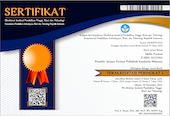Efektifitas Temulawak (Curcuma xanthorriza) Sebagai Pereduksi Formalin Pada Tahu
Abstract
To make a long lasting tofu some manufacturers typically add a preservative so that the shelf life of food products can last longer, some rogue manufacturers intentionally add preservatives that are prohibited such as formaldehyde. The aim of the study is to reduce the concentration of formaldehyde in tofu using curcuma based on literature it can reduce formaldehyde because it contains saponins that can form soap with formaldehyde. Tofu sample is contacted with formalin then given immersion treatment using curcuma solution. After that, a sample preparation is carried out to obtain the test solution which is reacted with Schiff reagents and measured by Spectrophotometer UV-Visible. The results obtained from this study are measurements made at a maximum wavelength of 558.10 nm. The linearity value obtained from the measurement results is 0.996. The linear regression equation for measurement is y = 0.12x - 0.399. The lowest reduction value is 3.29% while the highest reduction value is 23.04%. Based on the two-way ANOVA test, the two factors did not find a significant difference and based on the Tukey test the best concentration value was 7.5% and the best immersion time was 10 minutes. From the research it can be concluded that the temulawak solution can reduce the concentration of formalin in tofu.
Keywords : formaldehyde, curcuma, Curcuma xanthorriza
Untuk membuat tahu tahan lama beberapa produsen biasanya menambahkan suatu pengawet agar usia simpan produk pangan tersebut bisa bertahan lebih lama, beberapa produsen nakal sengaja menambahkan pengawet yang dilarang seperti formalin. Pada penelitian ini bertujuan untuk mereduksi konsentrasi formalin pada produk pangan tahu menggunakan temulawak karena secara teori temulawak dapat mereduksi formalin dikarenakan mengandung saponin yang dapat menyabunkan formalin.Sampel tahu dikontakkan dengan formalin kemudian diberikan perlakuan perendaman menggunakan larutan temulawak. Sampel tahu kemudian direaksikan dengan pereaksi Schiff dan diukur secara spektrofotometri UV-Visible. Hasil yang diperoleh dari penelitian ini adalah pengukuran dilakukan pada panjang gelombang maksimum 558,10 nm. Nilai linieritas yang diperoleh dari hasil pengukuran adalah 0,996. Persamaan regresi linier dari pengukuran adalah y = 0,12x – 0,399. Nilai reduksi terendah adalah 3,29% sedangkan nilai reduksi tertinggi adalah 23,04%. Berdasarkan uji two ways ANOVA kedua faktor tidak ditemukan perbedaan secara signifikan dan berdasarkan uji Tukey nilai konsentrasi yang terbaik adalah 7,5% dan waktu perendaman terbaik adalah 10 menit. Dari penelitian dapat disimpulkan bahwa larutan temulawak dapat mereduksi konsentrasi formalin pada tahu.
Kata kunci : formalin, temulawak, Curcuma xanthorriza
Full Text:
PDF (Bahasa Indonesia)References
Anam, M. K. et al. 2016. Deteksi Formalin Menggunakan Surface Plasmon Resonance (SPR) Berbasis Nanopartikel Perak sebagai Pengembangan Awal Teknologi Food Safety. Indonesian Journal of Applied Physics, 3(02), p. 201.
Berlian, Z. et al. 2017. Efektivitas Kunyit (Curcuma domestica) Sebagai Pereduksi Formalin Pada Tahu. Jurnal SainHealth, 1(1).
Bricker, C. F. and Johnson, H. R. 1945. Spectrophotometric Method for Determining Formaldehyde. Industrial and Engineering Chemistry - Analytical Edition, 17(6), pp. 400–402.
BSN, B. S. N. 1998. Standar Nasional Indonesia tentang Tahu. SNI 01-3142-1998, p. 1.
Damayanti, E., Ma’ruf, W. F. and Wijayanti, I. 2014. Efektivitas Kunyit (Curcuma longa Linn.) Sebagai Pereduksi Formalin Pada Udang Putih (Penaeus merguiensis) Penyimpanan Suhu Dingin. Jurnal Pengolahan dan Bioteknologi Hasil Perikanan, 3(1), pp. 98–107.
FDA, F. and D. A. 2020, Method Verification and Validation.
Harningsih, T. and Susilowati, I. T. 2015. Metode Reduksi Tahu Berformalin Air Garam Yang Ditambahkan Dengan Ekstrak Bawang Putih (Allium sativum L.). Jurnal KesMaDaSka, pp. 89–95.
Hayani, E. 2006. Analisis Kandungan Kimia Rimpang Temulawak. Temu Teknis Nasional Tenaga Fungsional Pertanian Bogor, pp. 309–312.
Kementrian Kesehatan Republik Indonesia. 2017. Farmakope Herbal Indonesia Edisi II. Kementrian Kesehatan Republik Indonesia.
Ma, T. H. and Harris, M. M. 1988. Review of the genotoxicity of formaldehyde. Mutation Research/Reviews in Genetic Toxicology, 196(1), pp. 37–59.
Mirna, La Karimuna, N. A. 2016. Analisis Formalin Pada Ikan Asin Di Beberapa Pasar Tradisional Kota Kendari. Jurnal Sains dan Teknologi Pangan, 1(1), pp. 31–36.
Putri, A. D. et al. 2016. Uji Kandungan Formalin Pada Buah Pepaya (Carica papaya L.) Dan Buah Nanas (Ananas comosus L.) Yang Di Jual Dilingkungan Uin Raden Fatah Palembang. jurnal Biota, 2(1).
Rahardjo, M. and Rostiana, O. 2005. Budidaya Tanaman Kunyit. in sirkuler.
Shurtleff, W. and Aoyagi, A. 2011. History of Tempeh and Tempeh Products (1815-2011). A Special Report on The History of Traditional Fermented Soyfoods.
Tisa Mandala Sari, Dira, S. 2017. Analisis Formalin Pada Ikan Asin Kembung Di Beberapa Pasar Di Kota Padang Dengan Metoda Spektrofotometer UV-Vis. UNES Journal of Scientech Research (JSR), 2(2), pp. 148–158.
Wang, J. K., Ye, J. A. and Liu, J. X. 2012. Effects Of Tea Saponins On Rumen Microbiota, Rumen Fermentation, Methane Production And Growth Performance-A Review. Tropical Animal Health and Production, 44(4), pp. 697–706.
Yazid, E. A. and Putri, E. V. 2017. Reduction Of Formaldehyde Levels In Tofu Using White Turmeric (Curcuma Mango) With Spectrophotometry. Journal of Islamic Pharmacy, 2(2), p. 5.
DOI: https://doi.org/10.32382/mf.v17i2.2328
Refbacks
- There are currently no refbacks.

This work is licensed under a Creative Commons Attribution-NonCommercial-ShareAlike 4.0 International License.
Kontak Editor
Hendra Stevani
Jurusan Farmasi Poltekkes kemenkes Makassar
email : hendra@poltekkes-mks.ac.id

This work is licensed under a Creative Commons Attribution-ShareAlike 4.0 International License.




.png)


